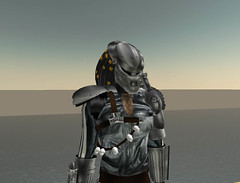This is a watershed moment in online and offline identity and expression that Google has brought to the fore for a lot of people. It’s apparent heavy handed policy on who you express yourself else on their profile pages for Google+ highlights many of the things I have been looking at, talkgin about and experiencing for atleast the past 10 years online.
This was and is the discussion and discovery process that people in “business” and “corporate” life have been bumping into. It cuts across virtual worlds, web 2.0, forums, IRC chat and almost any form of online communication. It also though, when you look at it, amplifies what happens in the physical face to face world.
When you engage in communication with another human being you use lots of cues to judge who it is you are talking to. Generally the main feature is the face. This is the pattern that you brain has remembered as the container for the thoughts and feelings of the person you are communicating with. It is a very strong, very rich and ever changing canvas of emotions and expressions. We think we can usually tell someones mood and intent by their face, and those expressions. In general we can, but it does not stop someone playing us, putting on an act or even entertaining us by pretending to be someone else in a play or movie. When someone is not present and we don’t have that face or that meeting we have word of mouth reputation, or the result of their actions expressed as products, buildings, statues etc.
When we go online we do not have that rich canvas of expressions and motion of a face. Even with a video conference we are translating and losing many of the cues we rely upon. Luckily though we can use more direct self expression, we can leave a trail of actions and intent as digital dna across the very systems we interact upon. We are evolving to understand what actions and what parts of the trail are of use for each of us in determining the viability of another digital representation in being worth interacting with. This applies to business as much as individuals. “They don’t even have a website/twitter account/facebook page/telephone number I am not going to bother shopping with them”
Profile pages, such as the google+ ones that are being policed in a rash way by google are merely a little bit of text and a picture (they do attach to many other things like a dna marker, but for now lets stick with the entry point). They are not your face, they are not you, they are a small veneer and advert to express to people what you do. In the old world that might be called a business card.
The name or names and text description of who are are representing yourself as are not the same as your physical collection of carbon atoms, that are recognisable by your face and may have a parental assigned label on them. You need to get across (should you choose too) why someone might be in the slightest bit interested in connecting with you. Now for people who already know you you given name may be the way they spot you, for others it may be that they have heard of you in some way and need to check you out and for other sets it may just be a serendipitous connection of interest. Each of those is not served by the same pieces of data.
Take the name. I am Ian Hughes I have no middle name, thats on my birth certificate etc. Government issued documents (i.e. validated by some people on the word of some other people). Yet my nickname/handle online of epredator is also how I am known. So we meet at a conference I say my name is Ian, you read my face see I am honest and upstanding but thats it. You meet me online I am Ian/epredator and you see that I have a nickname one that may intrigue, one that you may have even heard of. It may lead you to the conclusion that I have invested some time and effort in certain areas in order that I even have a nickname to share. It provides instant insight.
The same goes for photos.


The First picture is of me, its my face, you can tell I am wearing glasses, white male, getting on a bit. Smiling. Without the movement and expression of the face though does that really help you with who I am? Sure if we are going to meet then that may help, but so will the fact I will be wearing my striped leather jacket.
The second picture is of an avatar. A digital expression of me, labelled as epredator, wearing my striped leather jacket. However you can tell from a glance I am a science fiction fan. You may also guess if you are a fan of the culture that the predator character is very strong but full of honour. At no point is there anything where I do not represent who I am. “I wear a mask but don’t hide behind it”.
This just scratches the surface of identity, of me letting you know who I am using the restricted online means we have at our disposal.
This is me as an integrated identity, it is one of thousands of use cases that do not fit the if its you use your name/picture etc.
We are all learning this stuff, I am with me and who I am exploring, the problems and the benefits, I have been for years. “taking a bite out of technology so you don’t have to”. Hence like many I look at google+ and wonder what on earth they are playing at. They are missing some huge opportunities and hitting early adopters and explorers which will backfire on them. Nothing is too big to fail.
***UPDATE email from the google name police 25/1/2011
Hi,
Thank you for contacting us with regard to our review of the name you are
trying to use in your Google Profile. After review of your appeal, we have
determined that the name you want to use violates our Community Standards.
You can review our name guidelines at
http://www.google.com/support/+/bin/answer.py?answer=1228271
If you edit your name to comply with our policies in the future, please
respond to this email so that we can re-review your profile.
Sincerely,
Geoff
The Google Profiles Support Team
So I replied (and complied to get back in and see what the process is)
Hi,
I have edited my name back to Ian Hughes removing the Ian/epredator Hughes.
epredator is in other names I assume that will not give you a problem in the future.
Or am I allowed to be epredator Hughes? I am known mostly as epredator. I was assuming the / was the problem but hearing what is happening to others I assume you would fail that?
Thanks
Ian/epredator
Director of Feeding Edge Ltd
Taking a bite out of technology so you don’t have to.
Metaverse Evangelist
http://www.feedingedge.co.uk
http://www.twitter.com/epredator
http://en.wikipedia.org/wiki/Ian_Hughes_(epredator)
http://www.epredator.com
UPDATE 27/7/2011
I have been allowed back in
Hi Ian,
Thank you for contacting us with regard to the name you want to use with
your Google Profile. After further review, we have determined that your
name is within our Community Standards policy. Thank you for your patience
while we reviewed your profile name. Nicknames should be put in the
“Nicknames” or “Other names” section.
Sincerely,
Geoff
So I am now Ian Hughes on google+ though epredator is more than a nickname. It is part of my actual name. It feels that Google has cut off who I am to other people. I have complied, but will see what they manage to do to address this. It is NOT fixed. I will now get mixed up with a footballer from wales, the high commisioner of Sierra Leone and a journalist and an MD in the car industry. Nice one Google.
 Instead it is about getting people from diverse fields and setting then some social challenges in a rich creative settings and seeing who comes up with what to harness both existing Virtual Environments and spotting the gaps missing for the future.
Instead it is about getting people from diverse fields and setting then some social challenges in a rich creative settings and seeing who comes up with what to harness both existing Virtual Environments and spotting the gaps missing for the future. 









